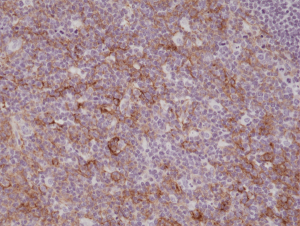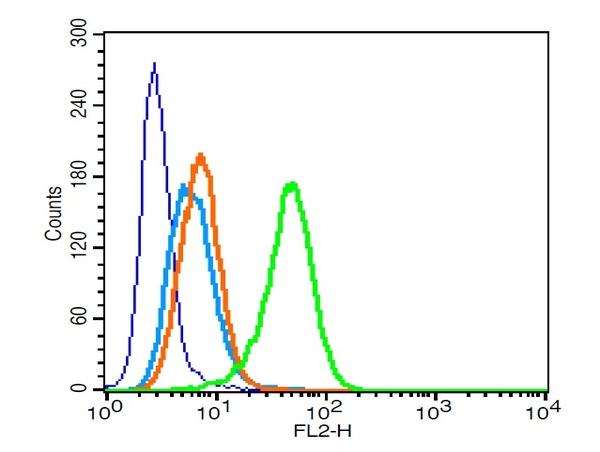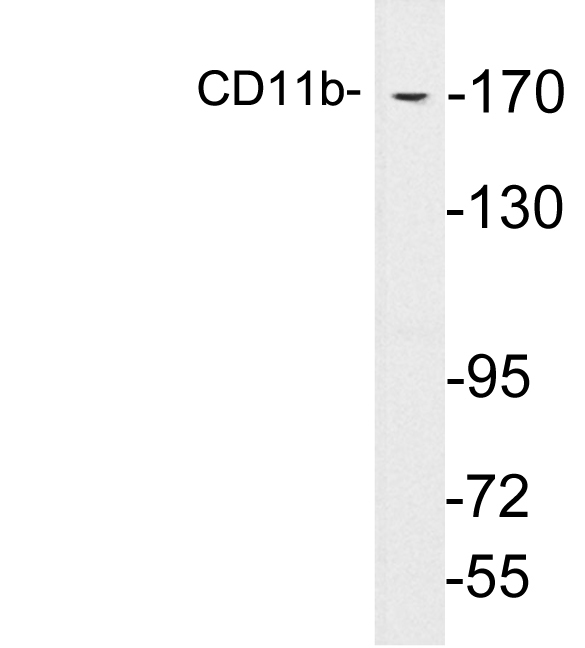
Immunohistochemical staining of formalin fixed and paraffin embedded human tonsil tissue sections using anti-CD11b rabbit monoclonal antibody (clone RM290) at a 1:200 dilution.
anti-CD11b (human), Rabbit Monoclonal (RM290)
REV-31-1174-00
ApplicationsWestern Blot, ImmunoHistoChemistry
Product group Antibodies
ReactivityHuman
TargetITGAM
Overview
- SupplierRevMAb Biosciences
- Product Nameanti-CD11b (human), Rabbit Monoclonal (RM290)
- Delivery Days Customer10
- ApplicationsWestern Blot, ImmunoHistoChemistry
- CertificationResearch Use Only
- ClonalityMonoclonal
- Clone IDRM290
- Gene ID3684
- Target nameITGAM
- Target descriptionintegrin subunit alpha M
- Target synonymsCD11B, CR3A, MAC-1, MAC1A, MO1A, SLEB6, integrin alpha-M, CD11 antigen-like family member B, CR-3 alpha chain, antigen CD11b (p170), cell surface glycoprotein MAC-1 subunit alpha, complement component 3 receptor 3 subunit, integrin, alpha M (complement component 3 receptor 3 subunit), leukocyte adhesion receptor MO1, macrophage antigen alpha polypeptide, macrophage-1 antigen alpha subunit, neutrophil adherence receptor alpha-M subunit
- HostRabbit
- IsotypeIgG
- Protein IDP11215
- Protein NameIntegrin alpha-M
- Scientific DescriptionIntegrins are transmembrane proteins that mediate interactions between adhesion molecules on adjacent cells and/or the extracellular matrix (ECM). Integrins have diverse roles in several biological processes including cell migration during development and wound healing, cell differentiation, and apoptosis. Their activities can also regulate the metastatic and invasive potential of tumor cells. They exist as heterodimers consisting of alpha and beta subunits. Some alpha and beta subunits exhibit specificity for one another and may be designated as a VLA (very late antigen) member. Heterodimers often preferentially bind certain cell adhesion molecules, or constituents of the ECM. Although they have no catalytic activity, integrins can be part of multimolecular signaling complexes known as focal adhesions. CD11b (Integrin alpha-M; ITGAM; Integrin alpha-X; ITGAX) is a 165 kDa adhesion molecule that associates non-covalently with integrin beta-2 (CD18). The CD11b/CD18 heterodimeric complex is also known as integrin alpha-M beta-2, Mac-1, and CR3 (complement receptor 3). CD11b is expressed on the surface of monocytes/macrophages, granulocytes, activated lymphocytes, a subset of NK cells, a subset of dendritic cells and microglia in the brain. CD11b/CD18 functions as the receptor for ICAM-1 (CD54), ICAM-2 (CD102), ICAM-4 (CD242), CD14, CD50, CD23, heparin, iC3b, fibrinogen and Factor X, these adhesions are critical for cell-cell and cell-matrix interactions. CD11b is commonly used as a microglial marker in nervous tissue. The expression of CD11b increases during monocyte maturation and expression levels vary on tissue macrophages. Diseases associated with CD11b dysfunction include systemic lupus erythematosus 6 and ITGAM-related susceptibility to systemic lupus erythematosus. - Recombinant Antibody. This antibody reacts to human CD11b (Integrin alpha-M). Applications: WB, IHC. Source: Rabbit. Liquid. 50% Glycerol/PBS with 1% BSA and 0.09% sodium azide. Integrins are transmembrane proteins that mediate interactions between adhesion molecules on adjacent cells and/or the extracellular matrix (ECM). Integrins have diverse roles in several biological processes including cell migration during development and wound healing, cell differentiation, and apoptosis. Their activities can also regulate the metastatic and invasive potential of tumor cells. They exist as heterodimers consisting of alpha and beta subunits. Some alpha and beta subunits exhibit specificity for one another and may be designated as a VLA (very late antigen) member. Heterodimers often preferentially bind certain cell adhesion molecules, or constituents of the ECM. Although they have no catalytic activity, integrins can be part of multimolecular signaling complexes known as focal adhesions. CD11b (Integrin alpha-M; ITGAM; Integrin alpha-X; ITGAX) is a 165 kDa adhesion molecule that associates non-covalently with integrin beta-2 (CD18). The CD11b/CD18 heterodimeric complex is also known as integrin alpha-M beta-2, Mac-1, and CR3 (complement receptor 3). CD11b is expressed on the surface of monocytes/macrophages, granulocytes, activated lymphocytes, a subset of NK cells, a subset of dendritic cells and microglia in the brain. CD11b/CD18 functions as the receptor for ICAM-1 (CD54), ICAM-2 (CD102), ICAM-4 (CD242), CD14, CD50, CD23, heparin, iC3b, fibrinogen and Factor X, these adhesions are critical for cell-cell and cell-matrix interactions. CD11b is commonly used as a microglial marker in nervous tissue. The expression of CD11b increases during monocyte maturation and expression levels vary on tissue macrophages. Diseases associated with CD11b dysfunction include systemic lupus erythematosus 6 and ITGAM-related susceptibility to systemic lupus erythematosus.
- ReactivityHuman
- Storage Instruction-20°C
- UNSPSC12352203






